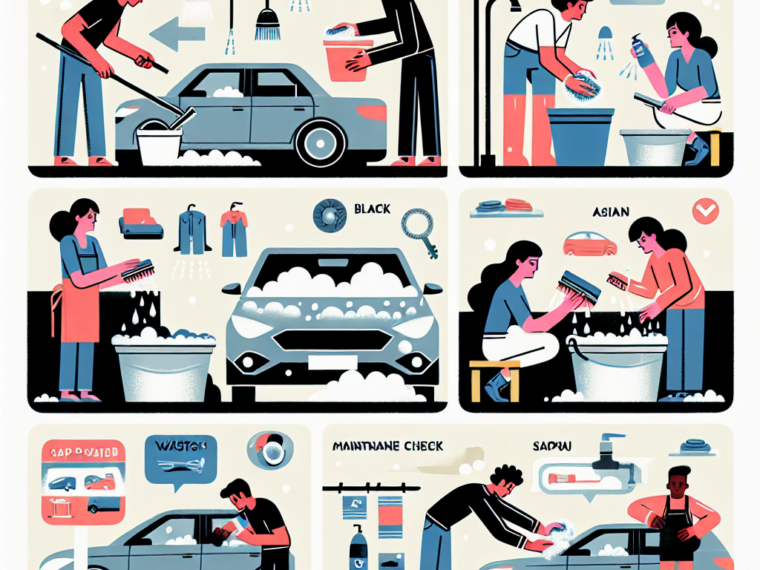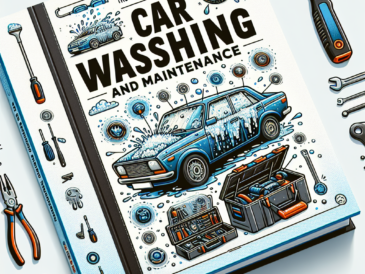I. Introduction
The Importance of Car Washing and Maintenance
Car washing and maintenance are essential for keeping your vehicle in top condition. Regular care not only enhances the appearance of your car but also plays a crucial role in preserving its value and performance over time. By following a consistent car care routine, you can ensure that your vehicle remains in optimal condition for years to come.
The Benefits of Regular Car Care
Engaging in regular car care offers numerous benefits. It helps to protect the paintwork, preventing rust and corrosion from developing. Additionally, maintaining clean and well-maintained vehicles can improve fuel efficiency and reduce the risk of mechanical issues. Regular car care also contributes to a safer driving experience, as it ensures that essential components such as brakes and tires are in good working condition.
Overview of the Book’s Content
This book provides a comprehensive guide to car washing and maintenance. It covers various aspects of car care, including washing techniques, interior cleaning, and routine maintenance tasks. Additionally, the book offers valuable tips and advice for preserving the appearance and functionality of your vehicle. Whether you are a novice or an experienced car owner, this book will equip you with the knowledge and skills needed to keep your vehicle in top condition.
II. Understanding the Basics of Car Washing
When it comes to car washing and maintenance, understanding the basics is crucial. This includes choosing the right car washing products, using proper techniques for hand washing, effectively utilizing a car wash facility, and tips for drying and detailing.
Choosing the Right Car Washing Products
One of the key aspects of car washing is selecting the appropriate products. This involves choosing a high-quality car shampoo that is gentle on the paintwork and does not strip away the protective wax. Additionally, selecting a microfiber wash mitt and soft drying towels can help prevent scratches and swirl marks on the vehicle’s surface.
Proper Techniques for Hand Washing
Hand washing your car requires the right approach to avoid damaging the paint. Begin by rinsing the car thoroughly to remove loose dirt and debris. Use the two-bucket method, with one bucket containing soapy water and the other clean water for rinsing the wash mitt. Work in sections, starting from the top and moving downwards to ensure a thorough and safe wash.
Using a Car Wash Facility Effectively
For those who prefer using a car wash facility, it’s essential to understand how to make the most of the experience. Choose a reputable facility with modern equipment and gentle cleaning products. Before entering the wash, ensure that all windows and sunroofs are closed, and the antenna is retracted to prevent any potential damage.
Tips for Drying and Detailing
After washing, proper drying and detailing are crucial for a flawless finish. Use a soft microfiber towel to gently dry the car, starting from the top and working downwards. Additionally, applying a quick detailer spray can enhance the shine and provide added protection to the paintwork.
III. Advanced Car Washing Techniques
When it comes to advanced car washing techniques, there are several methods that can help you achieve a thorough and effective clean for your vehicle.
Foam Cannon and Pressure Washing
One advanced technique for car washing is the use of a foam cannon and pressure washing system. This method allows for a more thorough and efficient application of soap and water, ensuring that all areas of the vehicle are properly cleaned.
Two-Bucket Method for Minimizing Swirls and Scratches
To minimize swirls and scratches on your vehicle’s paintwork, the two-bucket method is recommended. This involves using one bucket for the soapy water and another for rinsing the wash mitt, ensuring that any dirt and debris are not reintroduced to the clean water.
Dealing with Stubborn Stains and Contaminants
For stubborn stains and contaminants, it’s important to use specialized cleaning products and techniques. This may include the use of detailing clay to remove embedded contaminants, or specific stain removers for tough spots.
Choosing the Right Wax or Sealant for Protection
Finally, when it comes to protecting your vehicle’s paintwork, choosing the right wax or sealant is crucial. There are various options available, each offering different levels of protection and durability. It’s important to select a product that suits your specific needs and preferences.
IV. Maintaining Your Car’s Exterior
When it comes to keeping your car’s exterior in top condition, regular inspection for paint damage and corrosion is crucial. By carefully examining the paintwork and bodywork, you can identify any areas that may need attention before they develop into more serious issues.
Tips for Protecting the Car’s Exterior
Protecting your car’s exterior from environmental elements is essential for preserving its appearance and value. Parking in shaded areas, using car covers, and washing off bird droppings and tree sap promptly can help prevent damage from the sun, bird droppings, and other environmental hazards.
Understanding the Importance of Regular Waxing and Polishing
Regular waxing and polishing are key to maintaining your car’s exterior. Waxing provides a protective layer that shields the paint from the elements, while polishing helps to restore and maintain the shine of the paintwork. Both processes are essential for preserving the appearance and integrity of the car’s exterior.
Techniques for Maintaining a Clean and Shiny Exterior
To keep your car looking its best, it’s important to use the right techniques for cleaning and maintaining the exterior. This includes using high-quality car wash products, avoiding abrasive materials that can scratch the paint, and drying the car thoroughly to prevent water spots. Regular washing and detailing can help keep your car’s exterior clean and shiny.
V. Interior Care and Maintenance
When it comes to maintaining the interior of your car, there are several key areas to focus on. From cleaning and protecting the interior surfaces to proper vacuuming and upholstery care, ensuring that your car’s interior is well-maintained can make a significant difference in its overall appearance and comfort.
Cleaning and Protecting the Interior Surfaces
Regular cleaning of the interior surfaces is essential to keep them looking fresh and well-maintained. Use a mild interior cleaner and a soft microfiber cloth to gently wipe down the dashboard, door panels, and other hard surfaces. For leather seats, a specialized leather cleaner and conditioner can help keep them supple and prevent cracking.
Proper Vacuuming and Upholstery Care
Vacuuming the interior of your car on a regular basis is crucial for removing dirt, debris, and dust that can accumulate over time. Pay special attention to the crevices and seams where dirt tends to collect. Additionally, using a fabric upholstery cleaner can help remove stains and odors from the seats and carpets, keeping them looking and smelling fresh.
Tips for Maintaining a Fresh and Pleasant Interior Environment
To maintain a fresh and pleasant interior environment, consider using air fresheners or odor eliminators to keep the air inside your car smelling clean. Additionally, regularly airing out the interior by opening the windows can help reduce any lingering odors and keep the interior smelling fresh.
Dealing with Specific Interior Maintenance Challenges
Specific interior maintenance challenges, such as stubborn stains or odors, may require targeted solutions. For example, using a steam cleaner can be effective in removing tough stains from upholstery and carpets. In the case of persistent odors, consider using an odor-neutralizing spray or leaving a bowl of baking soda in the car overnight to absorb any unwanted smells.
VI. Maintaining Your Car’s Mechanical Components
Regular maintenance for your car’s engine and drivetrain is crucial for ensuring optimal performance and longevity. By following a few simple tips and guidelines, you can keep these components in top condition and prevent costly repairs down the road.
Importance of Regular Maintenance for Engine and Drivetrain
Regular maintenance helps to keep your engine and drivetrain running smoothly, reducing the risk of breakdowns and extending the lifespan of these critical components. It also ensures that your car operates efficiently, leading to better fuel economy and overall performance.
Tips for Checking and Maintaining Fluid Levels
Regularly checking and maintaining fluid levels such as engine oil, transmission fluid, coolant, and brake fluid is essential for preventing mechanical issues. Be sure to follow the manufacturer’s recommendations for fluid types and change intervals to keep your car running smoothly.
Understanding the Role of Filters and Belts in Car Maintenance
Filters and belts play a crucial role in maintaining your car’s mechanical components. Regularly inspecting and replacing air filters, oil filters, and fuel filters, as well as checking the condition of drive belts, can help prevent engine damage and ensure smooth operation.
Basic Troubleshooting and DIY Maintenance Tips
It’s important to familiarize yourself with basic troubleshooting and DIY maintenance tasks to address minor issues before they escalate. This includes checking for unusual noises, monitoring warning lights, and performing simple tasks like changing spark plugs or replacing air filters.
Ultimate Guide To Washing Your Car
What is the correct order to wash a car?
The correct order to wash a car is to start with the wheels and tires, then move on to the bodywork, and finally, clean the car interior.
How do I clean my car like a professional?
To clean your car like a professional, use high-quality car cleaning products, pay attention to each area of the vehicle, and follow a methodical car cleaning process to achieve professional results.
How do you build a successful car wash?
To build a successful car wash, focus on offering a range of car cleaning options, use quality cleaning chemicals and products, and provide excellent customer service to meet the preferences of car owners of all ages.
How do you wash your car effectively?
To wash your car effectively, use the 2 bucket method of washing, snow foam products, and a pressure washer to remove dirt and grime without risking scratches on the paintwork.
What is the 2 bucket method of washing a car?
The 2 bucket method of washing a car involves using one bucket for soapy water and another for rinsing the wash mitt, preventing contaminants from being transferred back onto the car’s paintwork.
Is it better to hand wash your car or car wash?
Hand washes can be better for your car’s paint and finish, as they allow for more control and attention to detail compared to automated car washes, which may risk causing scratches or water marks.
Why do cars run better after car wash?
Cars may feel better after a car wash due to the removal of dirt and contaminants that can affect the vehicle’s performance, as well as the added protection and shine from a quality wash and wax job.
How often should I wash my car?
The frequency of car washing depends on factors such as weather, usage, and personal preference, but generally, washing your car every 2-4 weeks can help maintain its appearance and resale value.
What are the weaknesses of a car wash business?
The weaknesses of a car wash business may include the risk of water marks, scratches, or using cleaning products that do not match the car’s paintwork, as well as the potential for high maintenance and operational costs.
Why do my car have streaks after washing?
Streaks on a car after washing can occur due to improper drying techniques or using low-quality cleaning products, which may leave behind residue or water marks on the vehicle’s surface.




